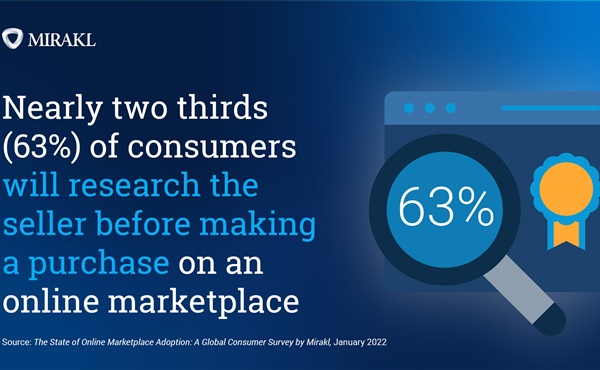Mirakl has released the 2022 State of Online Marketplace Adoption showing the steadily increasing uptake of online marketplaces by consumers globally, with 92 per cent of Australian consumers reporting that they expected to maintain or increase their marketplace usage into 2022.
According to the findings, the ecommerce landscape has shifted in response to rising consumer expectations around rapid delivery, product quality and variety, and lower pricing. Two-thirds of consumers surveyed globally prefer ecommerce sites with online marketplaces and 70 per cent say online marketplaces are the most convenient way to shop.
The global survey is comprised of insights from 9,000 consumers from nine countries across Australasia, Europe, North America and South America, exploring the ways in which consumers are shaping the online marketplace economy. Online marketplaces―being ecommerce sites that offer customers products from multiple sellers―grew more than double the rate of overall ecommerce in 2021.
As consumers spend more on marketplaces they are increasingly recognising the benefits that marketplaces offer. Mirakl’s research shows that the main factors for Australian consumers turning to online marketplaces were value and product selection, citing competitive prices and product variety as the top reasons they prefer marketplaces.
“The onset of the pandemic accelerated many changes in consumer behaviours that were already in place, with consumers turning to ecommerce options that were more convenient, faster, more reliable and accessible on the run or from the comfort of their own home,” Mirakl’s co-founder and co-CEO, Adrien Nussenbaum, says.
“Globally, nearly half (44 per cent) of consumers increased their use of marketplaces over the last 12 months, and two-thirds (66 per cent) of consumers prefer ecommerce websites that have an online marketplace over those who do not.

“Our data from The State of Online Marketplace Adoption shows that consumers globally see marketplaces as better positioned to meet their needs, with 60 per cent of Australian respondents identifying online marketplaces as the most convenient way to shop today. Roughly half of Australians clearly prefer ecommerce websites that have an online marketplace over those that do not, giving retailers a clear mandate to explore this innovative business model.
“Importantly for retailers, Australian shoppers on online marketplaces do their homework. Our survey data shows that over half of Aussie respondents will research a third-party seller before making a purchase on an online marketplace, with the majority of those checking the seller’s reviews,” he adds.
The emergence of the Covid-19 pandemic saw a sharp rise in the use of online marketplaces, with Australians’ usage of these marketplaces almost doubling from 26 per cent in 2019 to 43 per cent in 2020, and holding steady at that amount in 2021.
As people spend more online, marketplaces comprise a bigger share of their spending, a clear signal to retailers looking to grow their ecommerce businesses. High-volume, high-value online ‘power shoppers’ in Australia, shoppers who shop online once a week or more, conduct almost half (45 per cent) of their online purchases on online marketplaces, compared with 33 per cent for the average Australian. Two-thirds of these power shoppers in Australia said that they wish more of their favourite retailers had online marketplaces.
“In a time characterised by sudden changes, unpredictability and a need for flexibility, marketplaces are steadily gaining popularity among consumers, giving retailers the means to meet their customers’ rising expectations. This is no clearer than when considering power shoppers, whose shopping habits are leading the increasing popularity of online marketplaces,” says Nussenbaum.
“With 92 per cent of Australians expecting to maintain or increase their use of online marketplaces into 2022 and beyond, the number of retailers launching online marketplaces is sure to continue its growth, driven by popularity with consumers and retailers alike.”








